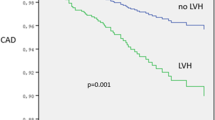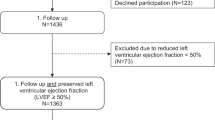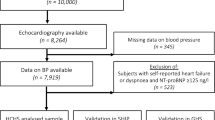Abstract
The objective of this study was to determine the electrocardiographic left ventricular hypertrophy (LVH) criterion that best correlated with vascular structure and function parameters in hypertensive patients. A cross-sectional study involving 347 hypertensive patients was performed. The mean age of the subjects was 54.9±11.8 years, and 61% were male. Electrocardiography was used to detect LVH based on the evaluation of 10 criteria, and we defined the voltage-duration product (VDP) complex criterion. The vascular structure was evaluated according to carotid intima-media thickness (C-IMT), and vascular function was evaluated according to pulse wave velocity (PWV), the ambulatory arterial stiffness index (AASI), the home arterial stiffness index, and the peripheral (PAIx) and central (CAIx) augmentation indices. LVH according to at least some electrocardiographic criteria was recorded in 29.10% of the patients (34.10% of females; 25.90% of males). The vascular structure and function parameters showed higher values in the hypertensive patients with LVH. The criterion most closely correlated with C-IMT was Lewis-VDP (r=0.257); with PWV and AASI, the criterion was the Framingham-adjusted Cornell voltage (r=0.228 and r=0.195, respectively); and with CAIx and PAIx, the criterion was Novacode (r=0.226 and r=0.277, respectively). In the multivariate analysis, the association of the vascular structure and function parameters, the VDP complex (multiple linear regression) and the presence of LVH (logistic regression) disappeared after adjusting for age, sex and antihypertensive drugs. The relationship between the electrocardiographic criteria used to detect LVH in hypertensive patients and the vascular structure and function parameters were fundamentally conditioned by age and antihypertensive drug treatment.
This is a preview of subscription content, access via your institution
Access options
Subscribe to this journal
Receive 12 digital issues and online access to articles
$119.00 per year
only $9.92 per issue
Buy this article
- Purchase on Springer Link
- Instant access to full article PDF
Prices may be subject to local taxes which are calculated during checkout

Similar content being viewed by others
References
Verdecchia P, Schillaci G, Borgioni C, Ciucci A, Gattobigio R, Zampi I et al. Prognostic value of a new electrocardiographic method for diagnosis of left ventricular hypertrophy in essential hypertension. J Am Coll Cardiol 1998; 31 (2): 383–390.
Okin PM, Devereux RB, Jern S, Kjeldsen SE, Julius S, Nieminen MS et al. Regression of electrocardiographic left ventricular hypertrophy during antihypertensive treatment and the prediction of major cardiovascular events. JAMA 2004; 292 (19): 2343–2349.
Pewsner D, Juni P, Egger M, Battaglia M, Sundstrom J, Bachmann LM . Accuracy of electrocardiography in diagnosis of left ventricular hypertrophy in arterial hypertension: systematic review. BMJ 2007; 335 (7622): 711.
Felix-Redondo FJ, Fernandez-Berges D, Calderon A, Consuegra-Sanchez L, Lozano L, Barrios V . Prevalence of left-ventricular hypertrophy by multiple electrocardiographic criteria in general population: Hermex study. J Hypertens 2012; 30 (7): 1460–1467.
Gonzalez-Juanatey JR, Cea-Calvo L, Bertomeu V, Aznar J . [Electrocardiographic criteria for left ventricular hypertrophy and cardiovascular risk in hypertensives. VIIDA study]. Rev Esp Cardiol 2007; 60 (2): 148–156.
Calderon A, Barrios V, Escobar C, Ferrer E, Barrios S, Gonzalez-Pedel V et al. Detection of left ventricular hypertrophy by different electrocardiographic criteria in clinical practice. Findings from the Sara study. Clin Exp Hypertens 2010; 32 (3): 145–153.
Barrios V, Calderon A, Coca A, Gonzalez-Juanatey JR, Sarria A, Rodriguez-Padial L . [Computerized interpretation of the electrocardiogram in the diagnosis of left ventricular hypertrophy. The ELECTROPRES project]. Rev Clin Esp 2011; 211 (8): 391–399.
Rodriguez-Padial L, Rodriguez-Picon B, Jerez-Valero M, Casares-Medrano J, Akerstrom FO, Calderon A et al. Diagnostic accuracy of computer-assisted electrocardiography in the diagnosis of left ventricular hypertrophy in left bundle branch block. Rev Esp Cardiol 2012; 65 (1): 38–46.
Hancock EW, Deal BJ, Mirvis DM, Okin P, Kligfield P, Gettes LS et al. AHA/ACCF/HRS recommendations for the standardization and interpretation of the electrocardiogram: part V: electrocardiogram changes associated with cardiac chamber hypertrophy: a scientific statement from the American Heart Association Electrocardiography and Arrhythmias Committee, Council on Clinical Cardiology; the American College of Cardiology Foundation; and the Heart Rhythm Society: endorsed by the International Society for Computerized Electrocardiology. Circulation 2009; 119 (10): e251–e261.
Hsieh BP, Pham MX, Froelicher VF . Prognostic value of electrocardiographic criteria for left ventricular hypertrophy. Am Heart J 2005; 150 (1): 161–167.
Chung CM, Lin YS, Chu CM, Chang ST, Cheng HW, Yang TY et al. Arterial stiffness is the independent factor of left ventricular hypertrophy determined by electrocardiogram. Am J Med Sci 2012; 344 (3): 190–193.
Masugata H, Senda S, Hoshikawa J, Murao K, Hosomi N, Okuyama H et al. Elevated brachial-ankle pulse wave velocity is associated with left ventricular hypertrophy in hypertensive patients after stroke. Tohoku J Exp Med 2010; 220 (3): 177–182.
Wang CP, Hung WC, Yu TH, Hsu HL, Chen YH, Chiu CA et al. Brachial-ankle pulse wave velocity as an early indicator of left ventricular diastolic function among hypertensive subjects. Clin Exp Hypertens 2009; 31 (1): 31–43.
Mancia G, De Backer G, Dominiczak A, Cifkova R, Fagard R, Germano G et al. 2007 ESH-ESC Practice Guidelines for the Management of Arterial Hypertension: ESH-ESC Task Force on the Management of Arterial Hypertension. J Hypertens 2007; 25 (9): 1751–1762.
World Medical Association declaration of Helsinki. Recommendations guiding physicians in biomedical research involving human subjects. JAMA 1997; 277 (11): 925–926.
Garcia-Ortiz L, Ramos-Delgado E, Recio-Rodriguez JI, Agudo-Conde C, Martinez-Salgado C, Patino-Alonso MC et al. Peripheral and central arterial pressure and its relationship to vascular target organ damage in carotid artery, retina and arterial stiffness. Development and validation of a tool. The Vaso risk study. BMC Public Health 2011; 11 (1): 266.
O'Brien E, Asmar R, Beilin L, Imai Y, Mancia G, Mengden T et al. European Society of Hypertension Working Group on Blood Pressure M. Practice guidelines of the European Society of Hypertension for clinic, ambulatory and self blood pressure measurement. J Hypertens 2005; 23 (4): 697–701.
Coca A, Bertomeu V, Dalfo A, Esmatjes E, Guillen F, Guerrero L et al. [Blood pressure self measurement: Spanish consensus document]. Nefrologia 2007; 27 (2): 139–153.
Groppelli A, Omboni S, Parati G, Mancia G . Evaluation of noninvasive blood pressure monitoring devices Spacelabs 90202 and 90207 versus resting and ambulatory 24-hour intra-arterial blood pressure. Hypertension 1992; 20 (2): 227–232.
O'Brien E, Petrie J, Littler W, de Swiet M, Padfield PL, O'Malley K et al. The British Hypertension Society protocol for the evaluation of automated and semi-automated blood pressure measuring devices with special reference to ambulatory systems. J Hypertens 1990; 8 (7): 607–619.
Gomez-Marcos MA, Recio-Rodriguez JI, Patino-Alonso MC, Agudo-Conde C, Gomez-Sanchez L, Gomez-Sanchez M et al. Protocol for measuring carotid intima-media thickness that best correlates with cardiovascular risk and target organ damage. Am J Hypertens 2012; 25 (9): 955–961.
Touboul PJ, Hennerici MG, Meairs S, Adams H, Amarenco P, Bornstein N et al. Mannheim carotid intima-media thickness consensus (2004-2006). An update on behalf of the Advisory Board of the 3rd and 4th Watching the Risk Symposium,13th and 15th European Stroke Conferences, Mannheim, Germany, 2004, and Brussels, Belgium, 2006. Cerebrovasc Dis 2007; 23 (1): 75–80.
Li Y, Wang JG, Dolan E, Gao PJ, Guo HF, Nawrot T et al. Ambulatory arterial stiffness index derived from 24-hour ambulatory blood pressure monitoring. Hypertension 2006; 47 (3): 359–364.
Van Bortel LM, Laurent S, Boutouyrie P, Chowienczyk P, Cruickshank JK, De Backer T et al. Expert consensus document on the measurement of aortic stiffness in daily practice using carotid-femoral pulse wave velocity. J Hypertens 2012; 30 (3): 445–448.
Lozano JV, Redon J, Cea-Calvo L, Fernandez-Perez C, Navarro J, Bonet A et al. [Left ventricular hypertrophy in the Spanish hypertensive population. The ERIC-HTA study]. Rev Esp Cardiol 2006; 59 (2): 136–142.
Barrios V, Escobar C, Calderon A, Ribas L, Marti D, Asin E . Prevalence of left ventricular hypertrophy detected by Cornell voltage-duration product in a hypertensive population. Blood Press 2008; 17 (2): 110–115.
Cuspidi C, Grassi G . Electrocardiographic diagnosis of left-ventricular hypertrophy: good news for the clinician? J Hypertens 2012; 30 (5): 884–886.
Cuspidi C, Meani S, Sala C, Valerio C, Negri F, Mancia G . Age related prevalence of severe left ventricular hypertrophy in essential hypertension: echocardiographic findings from the ETODH study. Blood Press 2012; 21 (3): 139–145.
Tsiachris D, Chrysohoou C, Oikonomou E, Lazaros G, Dimitriadis K, Maragiannis D et al. Distinct role of electrocardiographic criteria in echocardiographic diagnosis of left ventricular hypertrophy according to age, in the general population: the Ikaria Study. J Hypertens 2011; 29 (8): 1624–1632.
Paul J, Shaw K, Dasgupta S, Ghosh MK . Measurement of intima media thickness of carotid artery by B-mode ultrasound in healthy people of India and Bangladesh, and relation of age and sex with carotid artery intima media thickness: An observational study. J Cardiovasc Dis Res 2012; 3 (2): 128–131.
Cecelja M, Chowienczyk P . Dissociation of aortic pulse wave velocity with risk factors for cardiovascular disease other than hypertension: a systematic review. Hypertension 2009; 54 (6): 1328–1336.
Borlotti A, Khir AW, Rietzschel ER, De Buyzere ML, Vermeersch S, Segers P . Noninvasive determination of local pulse wave velocity and wave intensity: changes with age and gender in the carotid and femoral arteries of healthy human. J Appl Physiol 2012; 113 (5): 727–735.
Van Bortel LM, Laurent S, Boutouyrie P, Chowienczyk P, Cruickshank JK, De Backer T et al. Expert consensus document on the measurement of aortic stiffness in daily practice using carotid-femoral pulse wave velocity. J Hypertens 2012; 30 (3): 445–448.
Adiyaman A, Dechering DG, Boggia J, Li Y, Hansen TW, Kikuya M et al. Determinants of the ambulatory arterial stiffness index in 7604 subjects from 6 populations. Hypertension 2008; 52 (6): 1038–1044.
Shimizu M, Kario K . Role of the augmentation index in hypertension. Ther Adv Cardiovasc Dis 2008; 2 (1): 25–35.
Meijs MF, Doevendans PA, Cramer MJ, Vonken EJ, Velthuis BK, van der Graaf Y et al. Relation of common carotid intima-media thickness with left ventricular mass caused by shared risk factors for hypertrophy. J Am Soc Echocardiogr 2009; 22 (5): 499–504.
Matsui Y, Ishikawa J, Eguchi K, Hoshide S, Miyashita H, Shimada K et al. The influence of wave reflection on left ventricular hypertrophy in hypertensive patients is modified by age and gender. Hypertens Res 2008; 31 (4): 649–656.
Garcia-Garcia A, Gomez-Marcos MA, Recio-Rodriguez JI, Gonzalez-Elena LJ, Parra-Sanchez J, Fe Munoz-Moreno M et al. Relationship between ambulatory arterial stiffness index and subclinical target organ damage in hypertensive patients. Hypertens Res 2011; 34 (2): 180–186.
Gomez-Marcos MA, Recio-Rodriguez JI, Patino-Alonso MC, Gomez-Sanchez L, Agudo-Conde C, Gomez-Sanchez M et al. Ambulatory arterial stiffness indices and target organ damage in hypertension. BMC Cardiovasc Disord 2012; 12: 1.
Leoncini G, Ratto E, Viazzi F, Vaccaro V, Parodi A, Falqui V et al. Increased ambulatory arterial stiffness index is associated with target organ damage in primary hypertension. Hypertension 2006; 48 (3): 397–403.
Acknowledgements
We thank members of the Vaso risk group: L García-Ortiz, MA Gomez-Marcos, JI Recio-Rodríguez, C Agudo-Conde, MC Patino-Alonso, Emiliano Rodriguez-Sanchez, Emilio Ramos-Delgado, Luis J. González-Elena, Ángel García-García, Javier Parra-Sánchez, Carmela Rodríguez-Martín, Carmen Castaño-Sánchez, Angela de Cabo-Laso, Benigna Sánchez-Salgado (Unidad de Investigación de Atención Primaria La Alamedilla, Salamanca, Spain). We also thank Rosa Magallon-Botaya, Eva Andres (Instituto Aragonés de Ciencias de la Salud, Zaragoza, Spain); Carlos Martínez-Salgado, Ana M. Blázquez-Medela (Unidad de Fisiopatología Renal y Cardiovascular, Instituto Reina Sofía de Investigación Nefrológica, Universidad de Salamanca, Salamanca, Spain). This project was supported by the Health Service of Castilla y León (GRS 498/A/10, GRS 632/A/11), the Carlos III Health Institute of the Spanish Ministry of Health (RETICS RD06/0018, RedIAPP and RD06/0016, RedinRen) and the Infosalud Foundation.
Author information
Authors and Affiliations
Consortia
Corresponding author
Ethics declarations
Competing interests
The authors declare no conflict of interest.
Rights and permissions
About this article
Cite this article
Gómez-Marcos, M., Recio-Rodríguez, J., Patino-Alonso, M. et al. Relationship between electrocardiographic left ventricular hypertrophy criteria and vascular structure and function parameters in hypertensive patients. J Hum Hypertens 28, 186–192 (2014). https://doi.org/10.1038/jhh.2013.87
Received:
Revised:
Accepted:
Published:
Issue Date:
DOI: https://doi.org/10.1038/jhh.2013.87



